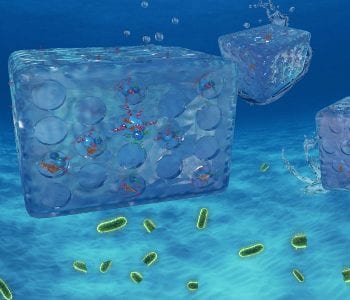 A major challenge for new technologies is providing safe drinking water for the world’s population, as contaminated water is a leading cause of death and disease around the world. Using a variety of techniques to develop hybrid scavenger nanoparticles, researchers in China have created an efficient and reusable water filter to effectively clean polluted water up to safe drinking standards. The nanoparticles are dispersed into a cellulose hydrogel to produce a practical water purification device. The rational design strategy used to create the hybrid, multi-functional nanoparticles should also be more generally applicable to other challenges in environmental science.
A major challenge for new technologies is providing safe drinking water for the world’s population, as contaminated water is a leading cause of death and disease around the world. Using a variety of techniques to develop hybrid scavenger nanoparticles, researchers in China have created an efficient and reusable water filter to effectively clean polluted water up to safe drinking standards. The nanoparticles are dispersed into a cellulose hydrogel to produce a practical water purification device. The rational design strategy used to create the hybrid, multi-functional nanoparticles should also be more generally applicable to other challenges in environmental science.
The use of adsorbant materials for water purification is a simple, cost- and energy-effective method. The ideal adsorbant material is highly selective and targets multiple pollutants, with a high adsorption capacity, as well as being fast-acting and reusable. While a convenient approach, adsorbant materials used for water purification typically have only some of these desired properties, as some of them are inherently contradictory – for example, strong binding to pollutants with good recyclability, and high selectivity with multi-targeting. The hybrid nanoparticles used in here combine these features for several classes of pollutant into a single, multi-functional particle.
To demonstrate the effectiveness of the new scavenger nanoparticle, the particles were integrated into a cellulose hydrogel, and placed into a empty filter unit from a commercially available water filter. The filter device was tested using an enviromental water sample, and levels of the target pollutant were successfully reduced to well below maximum safe drinking levels. The particles were also shown to be reusable after denaturing to remove the pollutants, withous significant loss of cleaning function over six cycles.
Using a two-step process, the hybrid nanoparticles are built piece by piece, starting with iron oxide–silver Janus nanoparticles. Each side of the Janus particle is then selectively functionalized by a different aptamer, specially chosen for the target pollutant. Here, the silver surface was functionalized with mercury-binding aptamers, while the iron oxide surface was decorated with bisphenol A-targeting aptamers. Three different types of pollutants can be targeted: mercury and bisphenol A via the aptamers, and bacterial pollutants via the anti-bacterial action of silver. The multi-functional nanoparticle can thus be specificaly designed for targeted pollutants. The resulting hybrid particle has a very open, porous structure, with large surface area for pollutant adsorption.

















